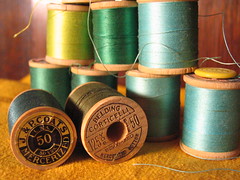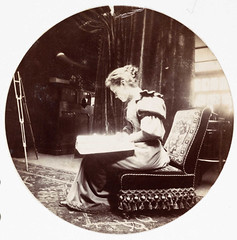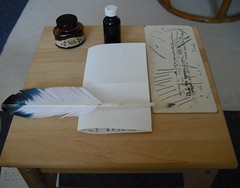 Image via CrunchBase
Image via CrunchBase
Recently I discovered that there is a web tool that will search my favourite blogs and will collect all of the newest posts in one location. It is called a blog aggregator or collector. The one I have chosen to use is called Google Reader. Please watch this video for an introduction to this tool.
When I signed up for Google Reader, I needed a Google account (I used my email account) and a password. I put all of my classmates' blogs into my Google Reader account. (Just copied and pasted each address into the Add subscription bar.) Our professor for this class had suggested that we find five other blogs to follow and collect them with a RSS (Real Simple Syndication) feed. I found two librarian blogs (one by Joyce Valenza and one by Amy Bowllan), Will Richardson's blog, CogDogBlog, and Tutvid's blog. In each case, I went to the main blog page and copied the address into the Add Subscription box.
As I have read these five blog posts as well as my classmates' blog posts, I have discovered other blogs to subscribe to. Currently I have 30 blogs on my Google Reader list. I read each of my classmates' blog posts twice a week and make comments on their posts as well. I try to read all of the other 23 blog posts once each week. However, now that I am trying to keep up with Twitter as well, I sometimes fall behind in reading all of the recent blog posts. However, I feel fortunate to not be in Jude's position. He has 558 subscriptions on Google Reader. He would like to trim it to 400. He says, in a comment on Weblogged, "Sometimes I think I was designed for an infor
Image by litlnemo via Flickr
Flickr
I have not yet tried the idea shown in the video above--searching for a topic in the Add Subscription box. At the moment, I prefer to follow people rather than topics or ideas. Maybe later on, as I refine my pursuit of information, I may begin to search for ideas as well as for people.
Some of the additional blogs that I have added since the first 14 required for this class, came because of following comment threads on others' blog posts (especially Will Richardson's comment threads). I am also picking up on other influential thinkers by following Tim O'Reilly's recommendations on Twitter. This is how I came across danah boyd.
Earlier this week, when Twitter was down and I realized that they had been under attack, I looked to one of the blogs I follow (TechCrunch) for information. TechCrunch is obviously written by a number of people since they post at least 6 times each day. On Thursday, I put Google Reader on List view and read the titles on the TechCrunch posts. I found one about Twitter and got all the latest news and speculation about the reason why it was down for so long that day. As well, I got a lot of chuckles from following the comments beneath the post. (I posted an account earlier of this hilarity. (See http://rielliott.blogspot.com/2009/08/hilarious-comment-thread.html)
As I follow these blogs, I am beginning to get a sense of where to go for certain kinds of information. Seth Godin's blog posts usually look at life from a commercial point of view and yet have universal applications of truth. In Will Richardson's blog entries, he pulls together things he's been reading and thinking about. Then he shares his observations. I find his blog so valuable, not just for his thoughts shared so transparently and yet professionally, but for the people who converse with him about those thoughts. The comment threads are amazing.
What do I look for in a good blog to follow? I like someone who posts at least twice a week. I like someone who has lots of comments, especially if their posts are about ideas. Obviously, the blogger can't ensure that they will have lots of comments. One would need many readers in order to have many people to comment. As we all know so well, not everyone who reads a blog post, comments on it. (I comment on my classmates' blog posts but rarely on anyone else's.)
Just a few more random thoughts about my process of using Google Reader to help
 Image by ex.libris via Flickr
Image by ex.libris via Flickr
I begin with the first blog post on my list. Often there are two or three posts on the same topic. I read them all and comment on at least one post. I make notes as I read so that my comments are specific to that post. Once I have finished all of the new posts for that blog, I click on Google Reader. Then I click on that blog and choose "Mark all as read". I go back to my blog roll and click on the next blog on the list. Sometimes this process takes a couple of days since some of the blog posts are really long. (Mine are long, too.) By the way, if I have any readers from outside the class, you may enjoy reading my classmates' blogs as well. Just click on any of the titles in my blog roll on the right hand side of this blog post. Then you can learn more about the latest tool that we are studying in this three day period.
As I think about my use of Google Reader, it is made possible by the fact that I am a good reader. I can quickly skim and scan for the information I need and discard the information that is less relevant. I am willing to read more slowly and reread text that is important and yet more difficult to understand. There are
 Image by National Media Museum via Flickr
Image by National Media Museum via Flickr
As we teach our students to use RSS feeds like Google Reader, we also need to teach them to use different reading rates for different purposes. We need to teach them to skim and scan and discard the unnecessary information. We need to teach them to slow down in order to learn and understand on a deeper level.
Here's an idea for junior high or high school students in their use of Google Reader. Each student would set up an account. They would select a topic that they are passionate about. Some possibilities could be homeless people, fashion, American Idol, chess, the Jonas brothers. The
 Image by Getty Images via Daylife
Image by Getty Images via Daylife
Unfortunately, many bloggers cease to publish new posts after a while. The blogs that I had on my favourites a few years ago, have all ceased to publish new material. Therefore I can't use my amazing new tool, Google Reader, to keep current with those bloggers' thoughts. Hope
 Image by studentofrhythm via Flickr
Image by studentofrhythm via Flickr
References:
Richardson, W. (12 Jan 2009). De-Echoing My Reading Practice. . .Help Wanted. In Weblogg-ed. Online at http://weblogg-ed.com/2009/deechoing-my-reading-practice/
![Reblog this post [with Zemanta]](http://img.zemanta.com/reblog_e.png?x-id=6b2b121e-cd4a-400c-a97e-decf91663921)





No comments:
Post a Comment